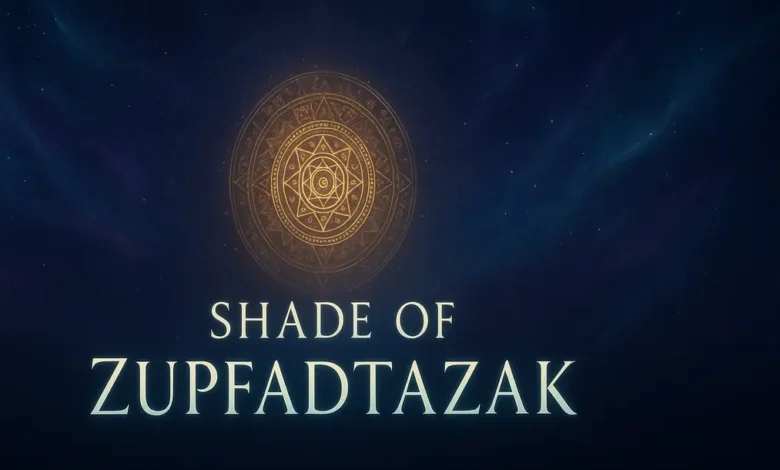Exploring the Enigmatic Shade of Zupfadtazak – Meaning, Origin, and Modern Influence

Introduction: The Mystery Behind the Shade of Zupfadtazak
When people hear the phrase shade of Zupfadtazak, they often pause, intrigued by its mysterious and almost poetic sound. It’s not just a name—it’s an expression that seems to carry layers of meaning, emotion, and imagination. Over time, shade of Zupfadtazak has evolved into something more than just a phrase; it represents a fusion of art, creativity, and individuality. Whether used in creative writing, design concepts, or cultural discussions, the shade of Zupfadtazak symbolizes depth, transformation, and perception.
Understanding the shade of Zupfadtazak begins with recognizing its versatility. It’s not a literal color you can find on a palette, but rather an abstract idea—a feeling that lives between tones, shadows, and expressions. Artists, designers, and even digital creators use the term to describe something that goes beyond what’s visible to the eye. It represents the essence of mood and the spirit of change.
In this article, we’ll dive deep into the origins, meanings, and modern interpretations of the shade of Zupfadtazak. From its aesthetic implications to its symbolic resonance, this concept invites us to explore the delicate space between imagination and reality.
The Origin and Concept of Shade of Zupfadtazak
This is not a recent phenomenon. It has roots that can be traced back to artistic experimentation and abstract thought. Although no single creator can claim ownership of the term, many theorists believe it originated in the digital art community—where color, texture, and symbolism often merge. The shade of Zupfadtazak became a metaphor for visual emotion, used by creators to describe that in-between space that words can’t quite define.
Historically, colors have been tied to emotion—blue for calm, red for passion, green for renewal. But shade of Zupfadtazak isn’t about a single hue. Instead, it represents the blending of multiple sensations, something that transcends traditional color theory. It is about perspective: how you feel when you see, experience, or interpret something new and undefined.
From a philosophical point of view, It also embodies ambiguity and transformation. It suggests that not everything in life fits neatly into categories. Sometimes, the most powerful meanings come from what we can’t quite describe. This makes shade of Zupfadtazak a modern symbol of open-mindedness and creative evolution.
The Emotional Depth of the Shade of Zupfadtazak
Emotionally, the shade of Zupfadtazak carries a weight that’s hard to put into words. It represents the quiet emotions that sit beneath the surface—the feelings we often overlook. For some, it might symbolize nostalgia; for others, serenity or even melancholy. What makes it fascinating is that its meaning changes depending on who experiences it.
Artists and writers often refer to the shade of Zupfadtazak as a feeling of subtle intensity. It’s that quiet moment before a storm, the calm that follows chaos, or the reflective silence after an emotional event. This emotional duality gives it a powerful psychological pull. It encourages introspection and self-discovery, urging people to look within rather than just at what’s around them.
Psychologists might interpret the shade of Zupfadtazak as a metaphor for the subconscious mind. Just like shades blend into one another, our emotions often mix, overlap, and shift over time. The concept reminds us that emotions aren’t linear—they exist in gradients, just like the shade of Zupfadtazak.
The Shade of Zupfadtazak in Art and Design
In the world of art and design, It has become a quiet revolution. It challenges traditional concepts of color and composition by introducing an idea that’s both abstract and deeply emotional. Designers use the phrase to describe color palettes that evoke mood rather than simply follow aesthetic trends.
For digital artists, the shade of Zupfadtazak often translates to an interplay between light and shadow. It can represent depth in digital paintings, realism in 3D rendering, or subtlety in photography. The magic of this shade lies in its ability to be everything and nothing at once—an emotional tone rather than a physical one.
In interior design, some creators have interpreted the shade of Zupfadtazak as a balance between warmth and coolness. It may appear in soft gradients, muted pastels, or deep, smoky hues that shift depending on lighting. The shade of Zupfadtazak in design is about evoking comfort, curiosity, and sophistication.
Cultural Interpretations of the Shade of Zupfadtazak
Culture plays a huge role in how we perceive color, and the shade of Zupfadtazak is no exception. In some interpretations, it’s seen as a metaphor for mystery and transformation—an idea that fits well with modern culture’s fascination with the unseen and undefined.
In Eastern philosophy, where balance and duality are often emphasized, the shade of Zupfadtazak represents harmony between extremes. It’s the space where light meets shadow, symbolizing balance and wisdom. In Western art culture, it has been used to express surrealism—the bridge between dreams and reality.
Social media and digital culture have also played a role in popularizing this. Influencers, digital artists, and NFT creators use the term to give depth to their work, associating it with individuality and uniqueness. It has become a cultural tag for those who think differently—those who prefer creativity over conformity.
The Symbolism Behind the Shade of Zupfadtazak
Symbolically, the shade of Zupfadtazak stands for complexity, depth, and evolution. It embodies the idea that nothing in life is purely black or white—there are always shades in between. This symbolism resonates deeply with modern audiences who are tired of rigid definitions and crave more nuance in art, thought, and emotion.
Many spiritual thinkers interpret the shade of Zupfadtazak as an aura color, suggesting transformation and enlightenment. It represents a soul in motion—a person or idea that’s constantly growing and adapting. This interpretation aligns with the psychological and creative aspects of the concept.
Even in literature, authors use the shade of Zupfadtazak as a metaphor for inner change. It might symbolize a character’s growth, emotional shift, or realization. The beauty of this phrase is that it gives language to something we all feel but rarely define—a subtle, shifting emotion that exists between joy and sorrow, light and dark.
Modern Relevance of the Shade of Zupfadtazak
In today’s fast-paced digital age, the shade of Zupfadtazak feels more relevant than ever. As people search for meaning in a world dominated by trends and algorithms, this concept offers something different—depth. It reminds us to slow down and appreciate the subtleties of life.
Brands and creators are beginning to use the shade of Zupfadtazak as part of their storytelling. In marketing, it represents authenticity and emotional intelligence—qualities that connect deeply with audiences. In music and film, it appears as a metaphor for emotional tone or visual mood.
This also aligns with the growing movement toward mindfulness and mental well-being. Just as mindfulness encourages awareness of the present, this shade reminds us to appreciate the nuances around us—the soft transitions, the blurred lines, and the quiet moments that define true beauty.
Conclusion: Embracing the Shade of Zupfadtazak
Ultimately, it isn’t just a color—it’s a mindset. It’s the recognition that beauty lies in complexity, that emotions come in layers, and that meaning can be found in subtlety. Whether you’re an artist, a thinker, or simply someone who appreciates the mysteries of life, the shade of Zupfadtazak invites you to see beyond the obvious.
It challenges us to interpret the unseen, to find inspiration in ambiguity, and to embrace the unknown. In a world obsessed with clarity and definition, it reminds us that the most powerful truths often live in the spaces between.
So, the next time you encounter something indescribable—a moment, a feeling, or an image—remember, you might just be witnessing the elusive shade of Zupfadtazak.



